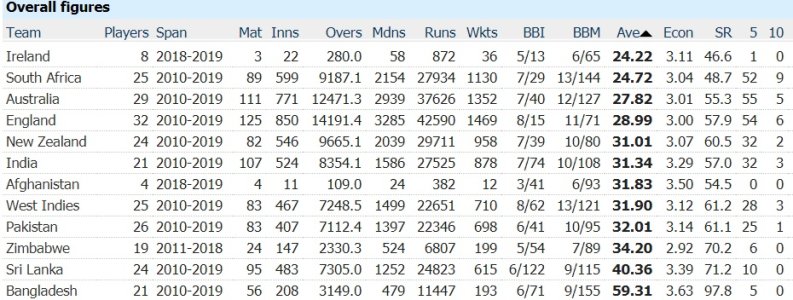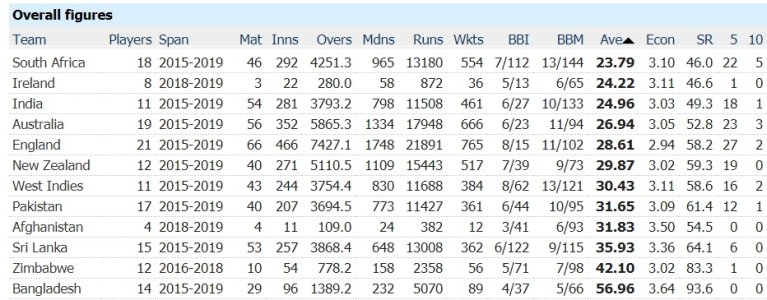The aim of this thread is emphatically not to get bogged down in arguments about Inzamam versus Misbah as Chief Selector or Mickey Arthur versus Misbah as Head Coach.
But in the midst of those arguments its impossible to get away from posters who either think that Pakistan is a minnow and sinking further, or else is a sleeping giant.
Similarly, I was accused of being disrespectful when I wrote prior to the Pakistan v Sri Lanka series that "of course Mickey Arthur would rather coach Pakistan than Sri Lanka if he had a choice".
It raises serious questions as to what Pakistan's true position in the Test world is.
I will get the ball rolling. I think that Pakistan's rightful position in Test cricket is generally around number 3 to 4, but that chaotic selection and poor management can drop that down lower, while careful selection and good management - arriving early for tours - can bump them up higher.
Why do I say this?
My stereotype of what a team needs to flourish as a Test power is as follows: 1 or 2 good pace bowlers and a decent batting line-up.
My analysis of the 10 Test countries goes as follows:
1. AUSTRALIA will always be in the top four countries. They always have decent pacemen who can bowl over 140, and they are professionally prepared.
2. INDIA will usually have an outstanding batting line-up, and decent spinners at home. But they rarely have a decent pace attack, which is why they lost their last series in England, New Zealand and South Africa.
3. ENGLAND are struggling to remain a Top Four power. The death of cricket in state schools and its absence from free-to-air TV mean that the base of followers is shrinking and generally they tend to have a couple of good batsmen and a couple of good medium pacers, but rarely the speed or height needed to do well in Australia, New Zealand or South Africa.
4. PAKISTAN should usually be a Top Four Test power, simply because they are generally second only to Australia in terms of decent quick bowlers over 140K. They usually only have a moderate batting lineup, but the sheer size of the cricketing base, combined with physical characteristics conducive to fast bowling, should usually keep Pakistan up there.
5. SOUTH AFRICA is a nation in steep decline. The white population has left in significant numbers and the African population remains generally disinterested - even Kagiso Rabada is a product of wealth. The cricketing base is down to around 4 million people, similar to New Zealand, and the cap on the number of white players who can be selected has diluted standards even further.
6. NEW ZEALAND is a country which punches above its weight. For now. They have thrived at the top of cricket's second division for years, powered by the batting of Williamson and Taylor and the bowling of Boult, supported by journeymen. But the situation looks very similar to when Hadlee and Martin Crowe departed - there is no major talent emerging and a spell in the Test doldrums looks just round the corner, with all three major stars close to the end of their careers. We saw at Perth that with even one of the three big players missing, the wholehearted effort of journeymen like BJ Watling and Neil Wagner is no longer enough to win matches.
7. SRI LANKA is another country which frankly punches above its weight. Their win in South Africa was a miracle and to be honest it remains baffling. Yes, South Africa is in serious decline. But Sri Lanka's bowling is so mediocre, and the batting so ordinary, that it is astonishing that they pulled this off a few weeks after being massacred in Australia.
8. WEST INDIES newfound minnow status is sadly no surprise. I was in Barbados for the first ever Day/Night Test there last year. There was no TV coverage at all, no public interest and it was made clear to me that because the satellite TV channels are from the USA, cricket is invisible and young kids take up American sports instead.
9. BANGLADESH is a team with very modest batting resources and a little bit of spin bowling, but there inability to find any pacemen of note in the Test arena is why they don't even get invited to Australia to tour at all.
When you look at these profiles, one thing becomes clear.
The First Division of Test nations will always contain Australia.
The Second Division will always contain Sri Lanka, Bangladesh and the West Indies.
India may well also now be fixtures in the First Division, although I have yet to see much indication that they have an emerging generation of pace talent comparable to Shaheen Shah Afridi and Naseem Shah.
For the others - England, New Zealand, Pakistan and South Africa - the two questions are:
1. Will enough talent emerge (or in England's case, be imported)?
2. Can professional preparation optimize their results and standing?
NEW ZEALAND
But in the midst of those arguments its impossible to get away from posters who either think that Pakistan is a minnow and sinking further, or else is a sleeping giant.
Similarly, I was accused of being disrespectful when I wrote prior to the Pakistan v Sri Lanka series that "of course Mickey Arthur would rather coach Pakistan than Sri Lanka if he had a choice".
It raises serious questions as to what Pakistan's true position in the Test world is.
I will get the ball rolling. I think that Pakistan's rightful position in Test cricket is generally around number 3 to 4, but that chaotic selection and poor management can drop that down lower, while careful selection and good management - arriving early for tours - can bump them up higher.
Why do I say this?
My stereotype of what a team needs to flourish as a Test power is as follows: 1 or 2 good pace bowlers and a decent batting line-up.
My analysis of the 10 Test countries goes as follows:
1. AUSTRALIA will always be in the top four countries. They always have decent pacemen who can bowl over 140, and they are professionally prepared.
2. INDIA will usually have an outstanding batting line-up, and decent spinners at home. But they rarely have a decent pace attack, which is why they lost their last series in England, New Zealand and South Africa.
3. ENGLAND are struggling to remain a Top Four power. The death of cricket in state schools and its absence from free-to-air TV mean that the base of followers is shrinking and generally they tend to have a couple of good batsmen and a couple of good medium pacers, but rarely the speed or height needed to do well in Australia, New Zealand or South Africa.
4. PAKISTAN should usually be a Top Four Test power, simply because they are generally second only to Australia in terms of decent quick bowlers over 140K. They usually only have a moderate batting lineup, but the sheer size of the cricketing base, combined with physical characteristics conducive to fast bowling, should usually keep Pakistan up there.
5. SOUTH AFRICA is a nation in steep decline. The white population has left in significant numbers and the African population remains generally disinterested - even Kagiso Rabada is a product of wealth. The cricketing base is down to around 4 million people, similar to New Zealand, and the cap on the number of white players who can be selected has diluted standards even further.
6. NEW ZEALAND is a country which punches above its weight. For now. They have thrived at the top of cricket's second division for years, powered by the batting of Williamson and Taylor and the bowling of Boult, supported by journeymen. But the situation looks very similar to when Hadlee and Martin Crowe departed - there is no major talent emerging and a spell in the Test doldrums looks just round the corner, with all three major stars close to the end of their careers. We saw at Perth that with even one of the three big players missing, the wholehearted effort of journeymen like BJ Watling and Neil Wagner is no longer enough to win matches.
7. SRI LANKA is another country which frankly punches above its weight. Their win in South Africa was a miracle and to be honest it remains baffling. Yes, South Africa is in serious decline. But Sri Lanka's bowling is so mediocre, and the batting so ordinary, that it is astonishing that they pulled this off a few weeks after being massacred in Australia.
8. WEST INDIES newfound minnow status is sadly no surprise. I was in Barbados for the first ever Day/Night Test there last year. There was no TV coverage at all, no public interest and it was made clear to me that because the satellite TV channels are from the USA, cricket is invisible and young kids take up American sports instead.
9. BANGLADESH is a team with very modest batting resources and a little bit of spin bowling, but there inability to find any pacemen of note in the Test arena is why they don't even get invited to Australia to tour at all.
When you look at these profiles, one thing becomes clear.
The First Division of Test nations will always contain Australia.
The Second Division will always contain Sri Lanka, Bangladesh and the West Indies.
India may well also now be fixtures in the First Division, although I have yet to see much indication that they have an emerging generation of pace talent comparable to Shaheen Shah Afridi and Naseem Shah.
For the others - England, New Zealand, Pakistan and South Africa - the two questions are:
1. Will enough talent emerge (or in England's case, be imported)?
2. Can professional preparation optimize their results and standing?
NEW ZEALAND








 imagine calling Watling that. The best test WK batsmen in the last 10 years is a journeyman?
imagine calling Watling that. The best test WK batsmen in the last 10 years is a journeyman?


